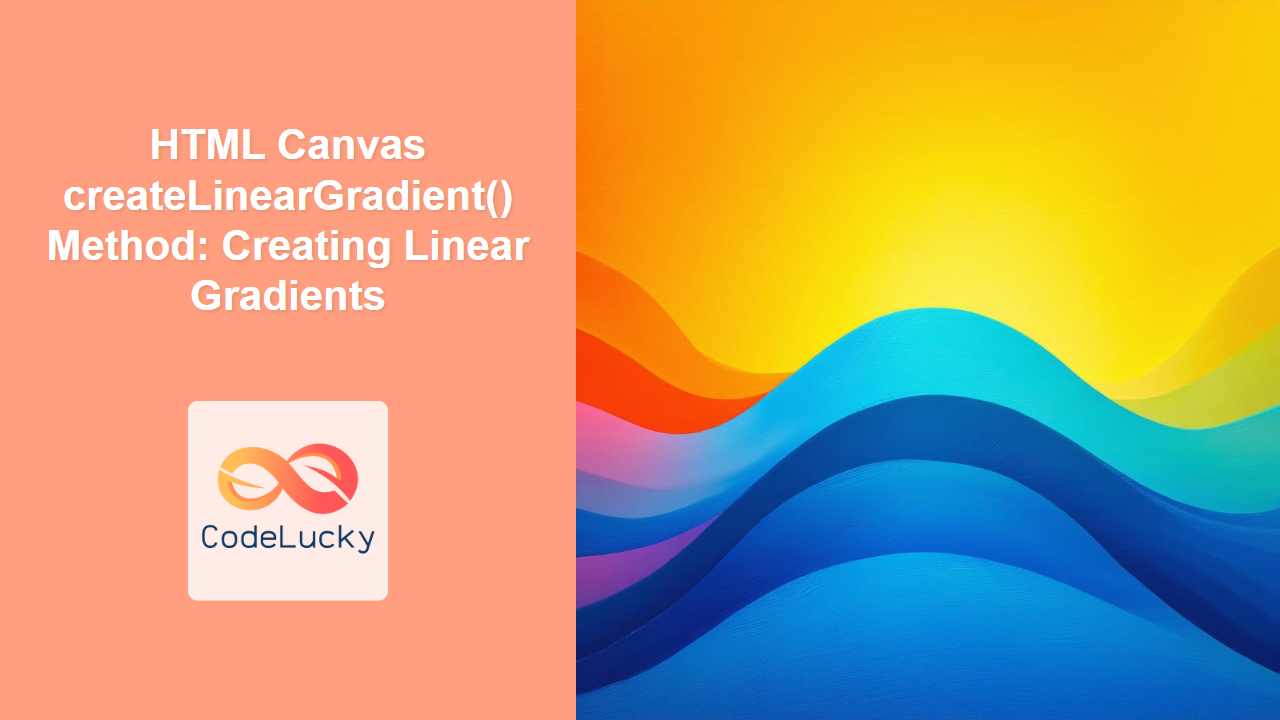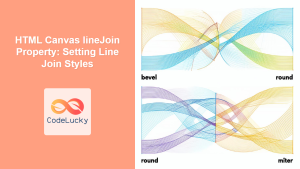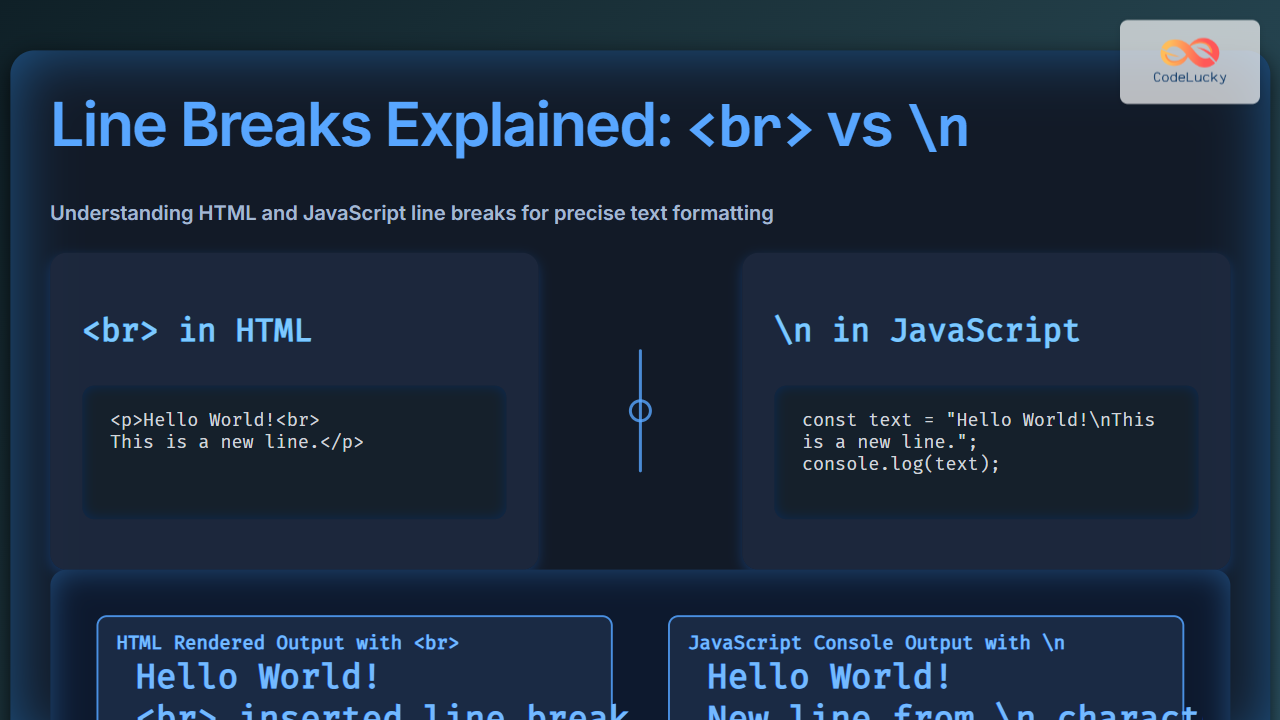The createLinearGradient() Method: Mastering Linear Gradients on HTML Canvas
The createLinearGradient() method in the HTML Canvas API is a powerful tool that enables developers to create smooth, visually appealing linear color transitions. Unlike solid colors, gradients add depth and dimension to canvas drawings, making them more engaging and professional. This article delves into how to effectively utilize createLinearGradient(), providing you with the knowledge to enhance your web graphics.
What is a Linear Gradient?
A linear gradient is a color transition along a straight line. It starts with one color and smoothly transitions to another color, or multiple colors, as defined by the developer. This effect is widely used in modern web design for backgrounds, shapes, text, and more.
Purpose of createLinearGradient()
The primary purpose of createLinearGradient() is to provide a dynamic method for creating these smooth color transitions on the HTML Canvas. This method allows developers to define the direction and colors of the gradient, offering a flexible tool for enhancing graphical elements. Key benefits include:
- Enhanced Visuals: Add depth, dimension, and professional touch to canvas drawings.
- Flexibility: Control the color stops, start and end points for gradients.
- Dynamic Effects: Create visually appealing effects through smooth color transitions.
- Customizable Designs: Implement creative color schemes and visual designs.
Syntax of createLinearGradient()
The createLinearGradient() method is called on the 2D rendering context of a canvas. It accepts four parameters: x0, y0, x1, and y1.
ctx.createLinearGradient(x0, y0, x1, y1);
Where:
x0: The x-coordinate of the starting point of the gradient.y0: The y-coordinate of the starting point of the gradient.x1: The x-coordinate of the ending point of the gradient.y1: The y-coordinate of the ending point of the gradient.
The return value is a CanvasGradient object, which is then used to define the color stops using the addColorStop() method.
The addColorStop() Method
The addColorStop() method is used to specify the colors and their position within the gradient.
gradient.addColorStop(offset, color);
Where:
offset: A number between 0 and 1, representing the position of the color stop within the gradient. 0 is the start and 1 is the end.color: A valid CSS color value.
Important CanvasGradient Properties
The CanvasGradient object created by createLinearGradient() does not have its own properties, but it relies on methods to define the gradient's appearance, specifically addColorStop().
Practical Examples of createLinearGradient()
Let's dive into some practical examples of using the createLinearGradient() method. Each example includes the necessary HTML and JavaScript code to render a gradient.
Basic Horizontal Gradient
The simplest use case for createLinearGradient() is a horizontal gradient.
<canvas
id="canvasHorizontalGradient"
width="300"
height="100"
style="border: 1px solid black;"
></canvas>
<script>
//<![CDATA[
const canvas_horizontal = document.getElementById("canvasHorizontalGradient");
const ctx_horizontal = canvas_horizontal.getContext("2d");
const gradient_horizontal = ctx_horizontal.createLinearGradient(0, 0, 300, 0);
gradient_horizontal.addColorStop(0, "red");
gradient_horizontal.addColorStop(1, "blue");
ctx_horizontal.fillStyle = gradient_horizontal;
ctx_horizontal.fillRect(0, 0, 300, 100);
//]]]]><![CDATA[>
</script>
Vertical Gradient
Creating a vertical gradient involves setting the start and end points along the y-axis.
<canvas
id="canvasVerticalGradient"
width="100"
height="300"
style="border: 1px solid black;"
></canvas>
<script>
//<![CDATA[
const canvas_vertical = document.getElementById("canvasVerticalGradient");
const ctx_vertical = canvas_vertical.getContext("2d");
const gradient_vertical = ctx_vertical.createLinearGradient(0, 0, 0, 300);
gradient_vertical.addColorStop(0, "yellow");
gradient_vertical.addColorStop(1, "green");
ctx_vertical.fillStyle = gradient_vertical;
ctx_vertical.fillRect(0, 0, 100, 300);
//]]]]><![CDATA[>
</script>
Diagonal Gradient
To create a diagonal gradient, set both the x and y coordinates for start and end points.
<canvas
id="canvasDiagonalGradient"
width="200"
height="200"
style="border: 1px solid black;"
></canvas>
<script>
//<![CDATA[
const canvas_diagonal = document.getElementById("canvasDiagonalGradient");
const ctx_diagonal = canvas_diagonal.getContext("2d");
const gradient_diagonal = ctx_diagonal.createLinearGradient(0, 0, 200, 200);
gradient_diagonal.addColorStop(0, "purple");
gradient_diagonal.addColorStop(1, "orange");
ctx_diagonal.fillStyle = gradient_diagonal;
ctx_diagonal.fillRect(0, 0, 200, 200);
//]]]]><![CDATA[>
</script>
Multiple Color Stops
Gradients can have multiple color stops to create more complex transitions.
<canvas
id="canvasMultiGradient"
width="400"
height="100"
style="border: 1px solid black;"
></canvas>
<script>
//<![CDATA[
const canvas_multi = document.getElementById("canvasMultiGradient");
const ctx_multi = canvas_multi.getContext("2d");
const gradient_multi = ctx_multi.createLinearGradient(0, 0, 400, 0);
gradient_multi.addColorStop(0, "red");
gradient_multi.addColorStop(0.25, "yellow");
gradient_multi.addColorStop(0.75, "green");
gradient_multi.addColorStop(1, "blue");
ctx_multi.fillStyle = gradient_multi;
ctx_multi.fillRect(0, 0, 400, 100);
//]]]]><![CDATA[>
</script>
Gradient with Transparent Colors
Use rgba() to create gradients with transparency.
<canvas
id="canvasTransparentGradient"
width="300"
height="100"
style="border: 1px solid black;"
></canvas>
<script>
//<![CDATA[
const canvas_transparent = document.getElementById(
"canvasTransparentGradient"
);
const ctx_transparent = canvas_transparent.getContext("2d");
const gradient_transparent = ctx_transparent.createLinearGradient(
0,
0,
300,
0
);
gradient_transparent.addColorStop(0, "rgba(255, 0, 0, 0.5)");
gradient_transparent.addColorStop(1, "rgba(0, 0, 255, 0.5)");
ctx_transparent.fillStyle = gradient_transparent;
ctx_transparent.fillRect(0, 0, 300, 100);
//]]]]><



















